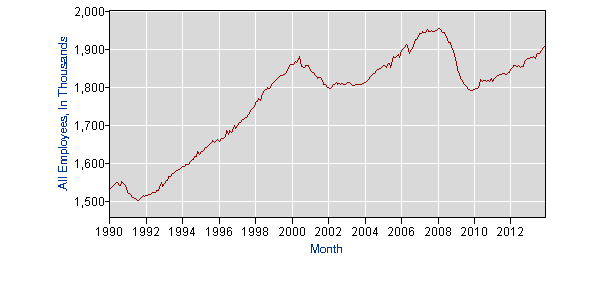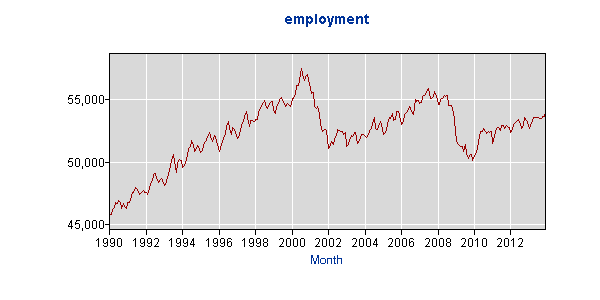Baby Boom and School Funding Update
By Alex Saitta
March 31, 2014
Update: I wrote this column on March 1, 2006. You can find the clean version under “Write-ups” with my 2006 columns. It is hard to believe it was eight years ago.
I think it would be helpful to look back at this write-up, update it and look forward at the same time. My original write-up is in black are in black and the updates are in red.
Public educators must begin to focus on ways to do more with the money they have, rather than always asking for more money when an additional need crops up. Improving economic efficiency is always a good thing, but the reason school districts must become more efficient is they'll have no choice. I believe the growth in education funding will slow over the next 5, 10 and 20 years.
This was quite an insightful comment for early-2006, because the economy was still humming along and it was a couple years before the economic crisis and “new normal” of lower revenue growth that followed.
In 2002 school district general fund spending was $80.3 million. In 2007 it was $95.9 million. In 2012 spending was $98.7 million, or a marked slow down the latter five year period.
Revenue growth fell, and the districts had no choice but to cut spending growth. Unfortunately, most didn’t see this coming, so spending was rising going into the revenue peak and our district had no savings. As a result, the cuts had to be more severe, and sudden, than if the district had anticipated what was coming.
Looking ahead it still looks depressed (it is a 20 year economic trend) with one thing added. Inflation is now higher, because the Federal Reserve is printing so much money. Real revenue growth is something to contend with now. Just because nominal revenue is up 3% or 4%, doesn’t mean a district is going to get a head. Likely inflation is just as high if not higher than that, because of rising costs for things like medical.
For starters, U.S. economic growth is on a slower track. In the 1980's Gross Domestic Product (GDP) grew an average of 3.1% a year. In the 1990's, GDP grew an average of 3.2% a year. Thus far over this decade, annual GDP has averaged a growth rate of 2.7%.
This was an accurate observation that picked up more traction the next few years. This past decade annual GDP growth was only 1.8%. So far this decade it is 2.3%, but we’ve yet to experience a recession. I thought we’d see a recession by now and I was wrong. GDP growth slowed as expected, 0.1% in 2012 Q4 and 1.1% in 2013 Q1, but no recession (GDP stayed positive). Continued GDP growth was due to all the money growth/ federal deficit spending (monetary and fiscal stimulus) the past five years.
Second, it is clear South Carolina economic growth is on an even slower track, lagging behind the national rate. For example, the state's unemployment rate is way above the national average.
Below is a graph of South Carolina total employment or what they call non-farm payroll. (It is from the Bureau of Labor Statistics or the federal agency that calculates employment/ unemployment at the federal, state and county levels.) The short-term trend is up, but the 14 year trend is flat. SC seems to still be shaking off its loss of manufacturing jobs. That is weighing on income growth statewide.
Third, and this is the key point, education funding is no longer the top priority of the baby boom. The baby boom began in 1946. By the early 1950's first of the baby boomers were putting a large physical demand on elementary schools. For example, in my district, 3 of the 5 elementary schools were built in the 1950's*. As those the boomers aged, in turn, the middle school was built in the 1960's.
When the baby boomers reached graduation, got married and had children, the demand to grow education funding continued. This time, the demand was of a political nature. The boomers were voting age, and wanted even better educations for their children, so they made sure their elected leaders continued to grow education spending through the 1970’s, 80’s and 90’s.
Now the children of the last baby boomers are graduating, and the initial baby boomers are retiring. The number one priority of the baby boom is no longer education. The boom's top priorities are health care and economic security. Just look at the AARP's website, and those priorities are clear.
Boomers aren't in school anymore, and neither are their children. As a result, they will no longer be advocates for more funding for public education. Instead, they'll want more money spent on health care.
Good insight in 2006, even that observation probably could have been made earlier. ObamaCare -- a huge national initiative costing hundreds of billions of dollars, indicates the trend is accelerating toward medical needs. Now in 2014, Healthcare has clearly established itself as the new number one priority domestically.
Do the math, the first of the baby boom was born in 1948 and started school in 1953. The last of the baby boom was 1964. They finished school in 1982. Ten years later or in 1992 the last of the baby boomers had their 3 children, and that last child graduated high schools in 2010. The boom had its most impact on public education from 1948 to 2010.
The 1948-boomers turned 65 years old in 2013. The last of the boomers -- the 1964-boomers -- will turn 65 in 2029. The 1964 boomers will continue to need intenstive medical care and things like affordable housing until they die off in the 2035 to 2045 era. The boom is just starting to have its greatest impact on medical/ affordable housing now in 2013 and that will continue to about 2045.
That is going to be a difficult adjustment for public education which has been the darling of the boomers from 1948 to 2010.
Additionally, as the boomers enter retirement, their incomes will stop rising, and they'll flatten out. They'll be on fixed incomes. As a result, they'll be less tolerant of tax increases. When boomers were 40 and 50 years old and their incomes were rising, tax increases were OK, especially tax increases for public education -- their top priority at the time. Now their kids are out of school, and boomers will be on a fixed income, the baby boom will be watching every dime they spend.
Updating that, boomers on fixed incomes are seeing their earning power eroded by inflation, so that adds another reason why I think they’ll be less tolerant of any tax hikes, education or otherwise. The official inflation rate — the CPI — understates true inflation. The CPI rate is 1.3%. Social Security cost of living increases are tied to the understated CPI rate. The price of goods and services we buy are rising about 5% a year, so boomers are seeing their incomes fall on a real basis.
SC Act 388 allocates state revenue to school districts based on the district’s growth in population and the CPI rate. Like I mentioned, CPI is understated, thus, the Act 388 allocation to school districts grows at an understated rate. In my opinion, the state and federal governments are both playing the bogus CPI rate to their advantage.
Looking at voting stats, seniors are more likely to vote, and their numbers are growing. What they want from our elected leaders, they will get.
Fourth, in Pickens County this national trend is going to be stronger. There is little job growth in Pickens County. For example, total employment is the same level now that it was in 1998. As a result, the county is not attracting those of the working age, but instead, retirees. Retirees, as a percentage of the population, are growing. Children between the age of 5 and 17 are falling as a percentage of the population.
Like the state of South Carolina, there has been improvement in the short-run due to the five-year economic expansion. That’s good, however, total employment is less in Pickens County than it was in 2000 (see chart below from the Bureau of Labor Statistics).
In 2000 the population was 110,000. Today it is about 120,000, yet there are no more workers in the county than there were then. That's a problem the entire nation is suffering from, more people but less workers.
I suspect what has happened to Pickens County is the same thing that occurred statewide — the loss of manufacturing jobs has put a lid on total job growth. All this weighs on state and local tax revenue, and hence education funding.
Funding for education will grow at a lower rate than it has in the past, so school districts are going to have to do a better job of managing the money they have and will get.
That 2006 conclusion was accurate. Looking ahead, the trend of low revenue growth will continue. The next shoe to drop, I believe, will be a pull back in Federal spending as the US continues to struggle under its mounting debt. Additionally, conservative Republicans will remain in control the US House (likely gain seats over time), and they are becoming more concerned with the deficit spending and monetarization of the debt by the Federal Reserve.
In my opinion, the school districts that will thrive will be the ones that best set priorities, reform their operations and efficiently manage their money.
* Looking at Pickens County's 29 schools, 9 of them were built in the 1950s. Second, 5 of the schools were built in the 1960's. I believe the boom helped to power the construction of schools in Pickens County.
Home Write-ups Videos About Us Contact Us


